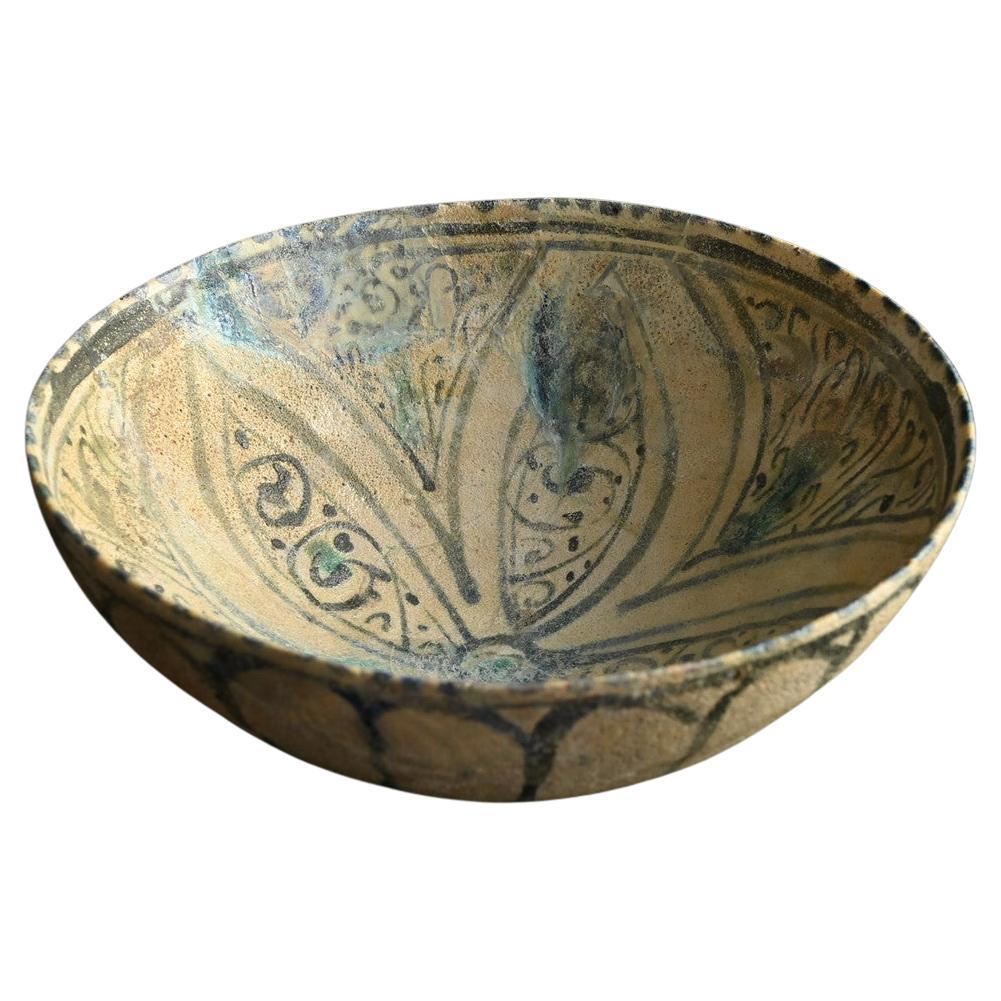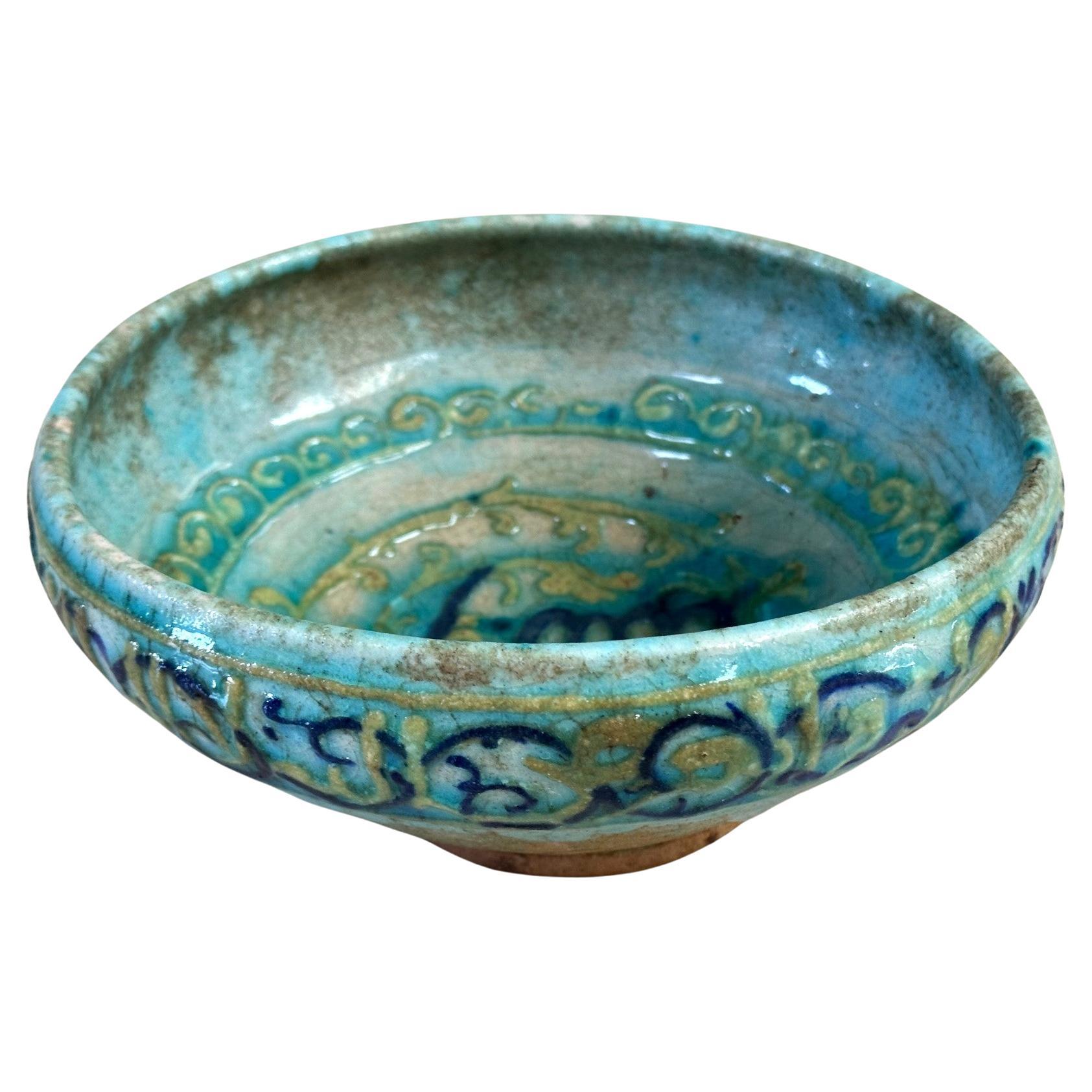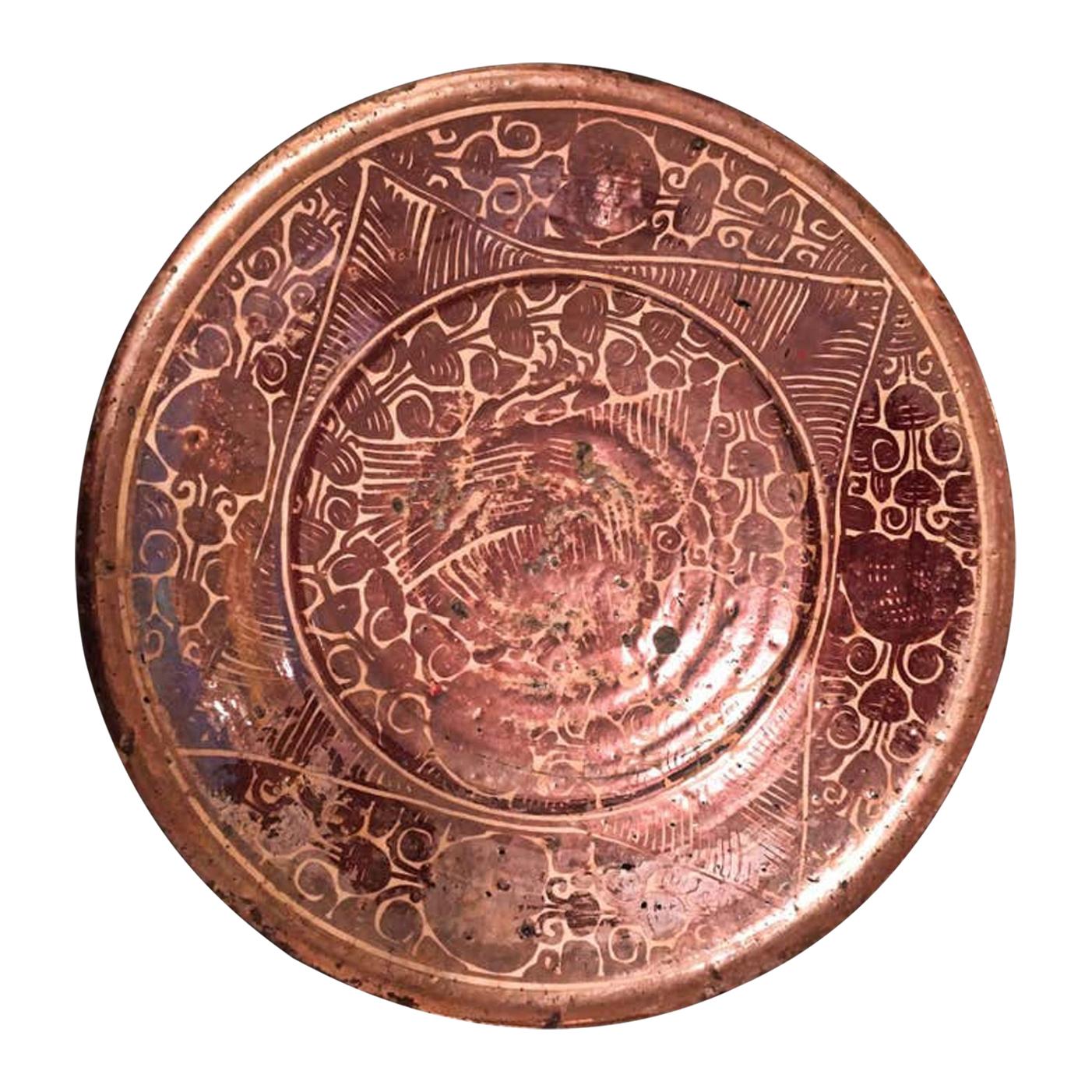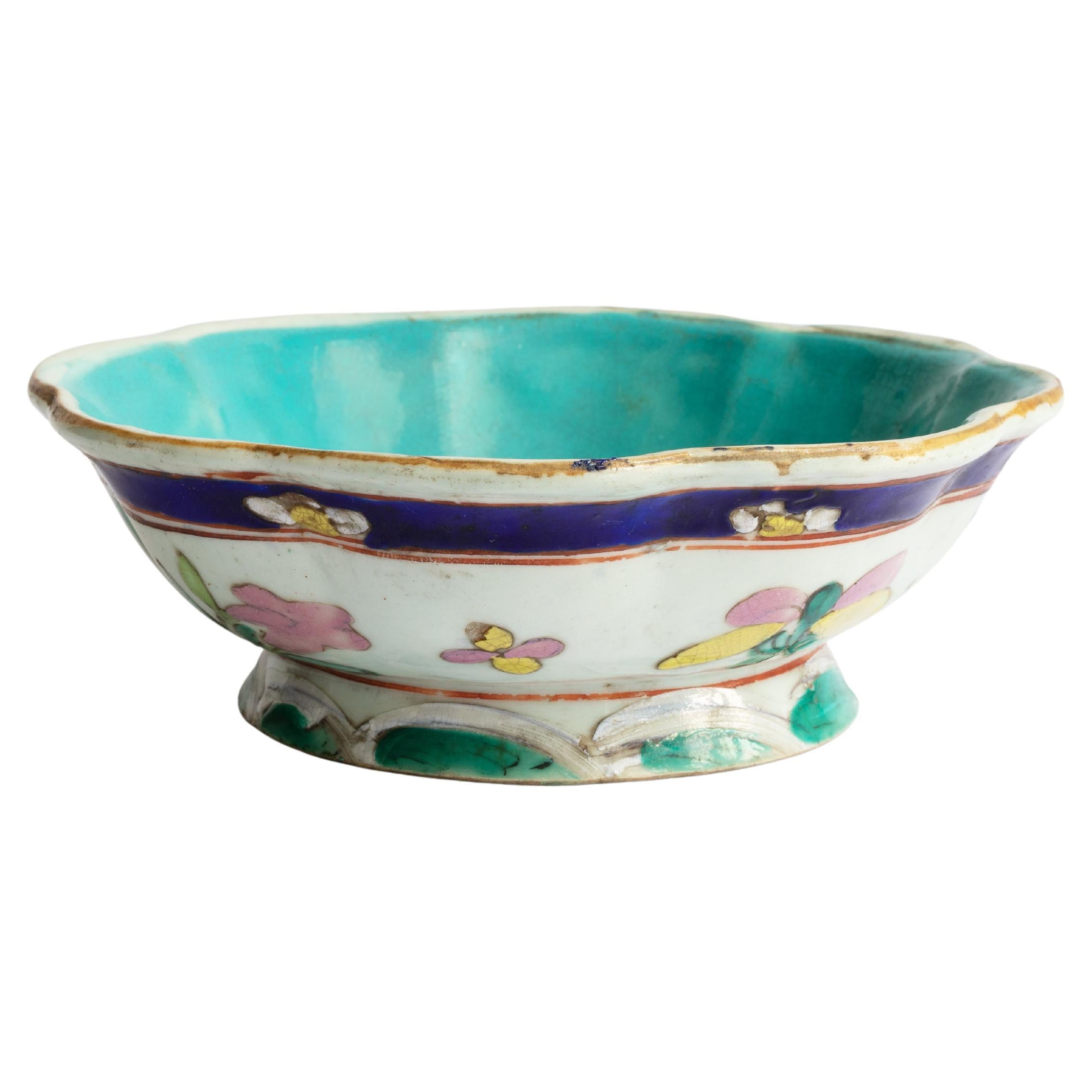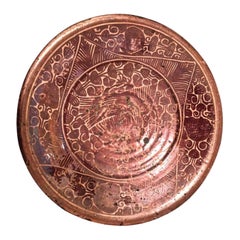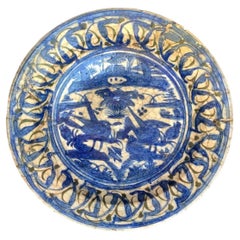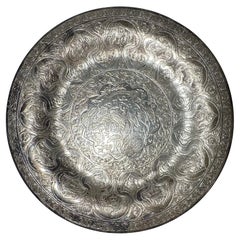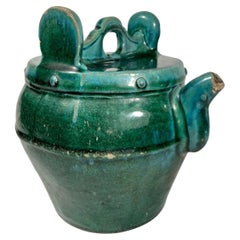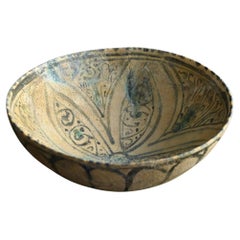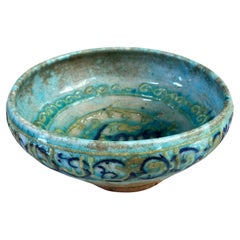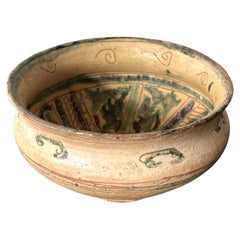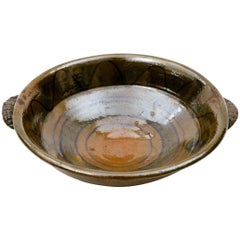Items Similar to Islamic Kashan 13th Century Turquoise Glazed Pottery Bowl
Video Loading
Want more images or videos?
Request additional images or videos from the seller
1 of 14
Islamic Kashan 13th Century Turquoise Glazed Pottery Bowl
$3,300
£2,488.53
€2,878.10
CA$4,629.88
A$5,146.40
CHF 2,697.63
MX$62,850.02
NOK 33,678.40
SEK 31,685.09
DKK 21,481.31
About the Item
Antique Islamic Kashan Persian 13th century turquoise glazed pottery bowl.
This bowl with vertical foot has interior paint in brilliant turquoise glaze against black stylized palmettes. It is from the Kashan region. The bowl is in an almost untouched state with beautiful strong colors on the surface. This must be one of the earliest bowls decorated in underglaze painting technique.
The condition is good with a few places of missing glaze.
Measurements: Diameter 12” x height 4”
Weight 3 ½ lbs.
- Dimensions:Height: 4 in (10.16 cm)Diameter: 12 in (30.48 cm)
- Style:Kashan (Of the Period)
- Materials and Techniques:Pottery,Glazed
- Place of Origin:
- Period:
- Date of Manufacture:circa 13th Century
- Condition:Wear consistent with age and use.
- Seller Location:Vero Beach, FL
- Reference Number:1stDibs: LU3915322582262
About the Seller
4.8
Gold Seller
Premium sellers maintaining a 4.3+ rating and 24-hour response times
Established in 2018
1stDibs seller since 2018
234 sales on 1stDibs
Typical response time: <1 hour
- ShippingRetrieving quote...Shipping from: Vero Beach, FL
- Return Policy
Authenticity Guarantee
In the unlikely event there’s an issue with an item’s authenticity, contact us within 1 year for a full refund. DetailsMoney-Back Guarantee
If your item is not as described, is damaged in transit, or does not arrive, contact us within 7 days for a full refund. Details24-Hour Cancellation
You have a 24-hour grace period in which to reconsider your purchase, with no questions asked.Vetted Professional Sellers
Our world-class sellers must adhere to strict standards for service and quality, maintaining the integrity of our listings.Price-Match Guarantee
If you find that a seller listed the same item for a lower price elsewhere, we’ll match it.Trusted Global Delivery
Our best-in-class carrier network provides specialized shipping options worldwide, including custom delivery.More From This Seller
View AllAncient Rare Kashan Lustre Bowl 12th Century Islamic Pottery Art
Located in Vero Beach, FL
Ancient rare Kashan lustre bowl 12th century Islamic pottery art.
This beautifully decorated and well cared for lustre bowl is one of the few examples still in existence. It was made in Kashan in the 12th-early 13th century, Seljuk- Atabeg period. Kashan was an important center for the production of high quality pottery and tiles. Lustre ware was among the most innovative development of Kashan potters, who mixed silver sulfides and copper oxides to create a shiny copper toned metallic sheen on the surface of glazed earthenware bowls, plates and vessels. It was an expensive and unpredictable lustre technique.
Kashan lustreware pottery can be found in the collections of the British Museum and the Hermitage Museum. Literature: O. Pancaroglu. Perpetual Glory. Medieval Islamic Ceramics...
Category
Antique 15th Century and Earlier Saudi Arabian Kashan Decorative Bowls
Materials
Pottery
$7,600 Sale Price
20% Off
Extremely Rare Islamic Safavid Blue and White Large Dish Persian 16th Century.
Located in Vero Beach, FL
Extremely Rare Islamic Safavid Blue and White Large Dish Persian 16th Century.
This Safavid fritware dish is painted under the glaze in black and cobalt blue. The rim is decorated w...
Category
Antique 16th Century Islamic Ceramics
Materials
Ceramic
Vintage Persian Zandi Middle Eastern Islamic Round S Brass Platter.
Located in Vero Beach, FL
Vintage Persian Zandi Middle Eastern Islamic Round Silver-Plated Brass Platter.
This distinctive, handcrafted silver-plated heavy gauge brass platter is engraved, embossed and punc...
Category
20th Century Indian Moorish Platters and Serveware
Materials
Silver Plate, Brass
Antique Chinese Green Blue Shiwan Pottery Teapot
Located in Vero Beach, FL
Antique Chinese Green Blue glazed Shiwan pottery teapot dates to China’s Kuang Hsu Dynasty and is of the late 19th century. The vibrant teal-green glaze pot...
Category
Antique Late 19th Century Chinese Qing Ceramics
Materials
Ceramic
Large Chinese Qing Dynasty Polychrome Enamel Bronze Cloisonne Charger
Located in Vero Beach, FL
Large Chinese Qing Dynasty polychrome enamel bronze cloisonne charger.
Unusual and rare bronze Chinese Qing Dynasty Cloisonne charger. The brightly ...
Category
Early 20th Century Chinese Qing Metalwork
Materials
Bronze, Enamel
Pair of Islamic Enameled Vessels, Ancient Urns
Located in Vero Beach, FL
This is an exceptional and historic pair of Damascus enameled metalwork vessels or urns. These art objects show signs of rough use and handling through the centuries. Although it is ...
Category
Antique 16th Century West Asian Islamic Urns
Materials
Enamel
$4,240 Sale Price
20% Off
You May Also Like
Very old Iranian blue-glazed pottery bowl/12th century/Persia pottery
Located in Sammu-shi, Chiba
This pottery was made around the 12th century, likely in the region around Iran.
In Japan, this type of pottery is commonly known as "Persian pottery."
In addition to polychrome-pain...
Category
Antique 15th Century and Earlier Persian Other Decorative Bowls
Materials
Pottery
Islamic Glazed Ceramic Bowl with Relief Inscription
Located in Atlanta, GA
An Islamic glazed ceramic bowl with inscription attributed to Raqqa ware, produced during the Ayyubid dynasty (12-13th century) in the town of Raqqa in nowadays northeastern Syria. T...
Category
Antique 15th Century and Earlier Syrian Islamic Pottery
Materials
Ceramic
Antique Islamic Ceramic Glazed Bowl with Splashed and Sgraffito Decoration
Located in Atlanta, GA
A small Islamic ceramic bowl circa 11-12th century, possibly from Nishapur or Aghkand area of Persia. The elegantly shaped bowl with a slightly flared opening is supported on a small foot rim. The earth ware...
Category
Antique 15th Century and Earlier Persian Islamic Ceramics
Materials
Ceramic
Spanish Colonial Majolica Ceremonial Bowl
Located in New York, NY
Spanish Colonial Majolica glaze ceramic ceremonial bowl, circa late 18th-early 19th century, Guatemala Highlands.
Category
Antique 19th Century Guatemalan Spanish Colonial Decorative Bowls
Materials
Pottery
Chinese Tongzhi Floral Offering Bowl, Turquoise Glaze, 1800s
Located in Lisbon, PT
A 19th-century Chinese porcelain offering bowl from the Tongzhi period (1862–1874) used for ceremonial tributes. These bowls were typically placed before ancestral altars, filled wit...
Category
Antique 19th Century Chinese Chinese Export Decorative Dishes and Vide-P...
Materials
Porcelain
$1,908 Sale Price
20% Off
Persian Safavid Fritware Bowl, c.17th Century
Located in Savannah, GA
A larger blue and white Safavid period Persian fritware bowl, circa 17th century.
9 inches wide by 4 inches tall
Category
Antique 17th Century Persian Decorative Bowls
Materials
Stoneware
More Ways To Browse
13th Century
Islamic Antiques
Antique Islamic Furniture
13th Century Furniture
Antique Kashan
Turquoise Pottery
Turquoise Glazed Pottery
Turquoise Bowl
Blue Footed Bowl
Saudi Arabia Furniture
Antique Blue Kashan
Footed Pottery Bowl
Turquoise Glaze Bowl
Turquoise And Black Pottery
Persian Pottery
Persian Bowl
Antique Islamic Pottery
Arabia Pottery
